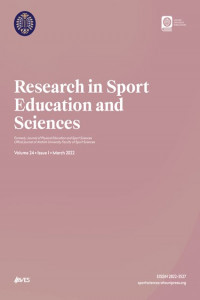TÜRKİYE SÜPER LİGİ TAKIMLARININ 2014-2015 SEZONDA GÖRÜLEN YARALANMALARIN DEĞERLENDİRİLMESİ
Futbol, Yaralanma, Süper lig, Yaralanma İnsidansı
EVALUATION OF THE INJURIES SUSTAINED BY THE ATHLETES OF TURKISH SUPER LEAGUE TEAMS IN 2014-2015 SEASON
Football, Injury, Super league, Incidence of Injury,
___
- Açak M., & Karademir, T. İşitme engelli futbolcuların yaralanma insidansı. Spor ve Performans Araştırmaları Dergisi, 2012;3(1).
- Adamczyk G, Luboinski.L. epidemiologia of football, related ınjuries part ı. Acta Clinica, 2002; (2);236-50 . Arnason A, Sigurdsson SB, Gudmundsson A, Holme I, Engebretsen L, Bahr R. Risk factors for injuries in football. Am J Sports Med,2004;32:S5-16.
- Bağrıaçık A, Açak M. Spor Yaralanmaları ve Rehabilitasyon. İstanbul: Morpa Kültür Yayınları Ltd. Ş, ,2005; 14.
- Bayraktar, B., Dinç, C, Yücesir, İ., & Evin, A. Injury evaluation of the Turkish national football team over six consecutive seasons. Turkish Journal of Trauma & Emergency Surgery,2011;17(4), 313-317.
- Bruijn J V, Keizers. S. Sports injury registration: the fysion blesreg system. British Journal of Sports Medicine,1991;25:124-8.
- Chomiak J, Junge, A, Peterson, L, Dvorak, J. Severe injuries in football players. Influencing factors. American Journal of Sports Medicine, 2000; 28; 58-68.
- Cromwell F, Walsh J, Gormley J A. Pilot study examining injuries in elite Gaelic footballers, British Journal of Sports Medicine, 2000;34; 104-12.
- Ergün, M., Denerel, H. N., Binnet, M. S., & Ertat, K. A. Injuries in elite youth football players: a prospective three-year study. Acta Orthop Traumatol Turc,2013; 47(5), 339-346.
- Ergen E. Ankara :Spor Hekimliği, Sporda Sağlık Sorunları ve Sakatlıklar, 1986; 20-5.
- Fuller CW.Ekstrand J, Junge A, Andersen TE, Bahr R, Dvorak J, et al. Consensus statement on injury definitions and data collection procedures in studies of football (soccer) injuries. Clin J Sport Med,2006;16:97-106.
- Gustafsson R, Hodson A. Football medicine in the team. In: Football Medicine. Ekstrand J, Karlsson J, Hodson A eds. Revised ed,2003; p.11-39.
- Hägglund M, Waldén M, Bahr R, Ekstrand J. Methods for epidemiological study of injuries to professional football players: developing the UEFA model. Br J Sports Med,2005;39:340-6.
- Hawkins RD, Hulse MA, Wilkinson C, Hodson A, Gibson M. The association football medical research programme: An audit of injuries in professional football. Brit J Sports Med,2001;35:43-7.
- Hoy K, Hellelan HE, Lindbad-Terkelsen CJ. European soccer injuries, a prospective epidemiologic and socioeconomic study. Am J Sports Med, 1992; 20:318-22.
- Jorgensen U. Epidemiology of injuries in typical Scandinavian team sports. J Sport Med, 1984;18:59-63.
- Maehlum S. Football injuries in Oslo: A one year study. Brit J Sports Med, 1984;18:186-1.
- Ozdayi N.,Ugurlu F. Spor, Egzersiz ve Antrenman Bilimi,2015; Cilt 1, Sayı 1, 31-39.
- Powell J.W. National injury/illness reporting system: Eye injuries in college wrestling.Int. Opht. Clin,1981;21, 47-58.
- Rahmana N, Reilly T, Lees A. Injury risk associated with playing actions during competitive soccer. Brit J Sports Med, 2002;36:354-9.
- Reilly, T. Science and Soccer. Ed. E & FN SPON. London: Chapman & Hall,1996;25 – 64.
- Woods C, Hawkins R, Hulse M, Hodson A. The Football Association Medical Research Programme: An audit of injuries in professional football-analysis of preseason injuries. Brit J Sports Med,2002;36:436-41.
- Başlangıç: 2020
- Yayıncı: Atatürk Üniversitesi
TÜRKİYE SÜPER LİGİ TAKIMLARININ 2014-2015 SEZONDA GÖRÜLEN YARALANMALARIN DEĞERLENDİRİLMESİ
Ramazan BAYER, Mahmut AÇAK, M.fatih KORKMAZ
YETİŞTİRME YURDUNDA KALAN LİSE DÜZEYİNDE ÖĞRENCİLERİN SPORA YÖNELİK TUTUMLARININ İNCELENMESİ
Orcan MIZRAK, Yunus Sinan BİRİCİK, Emre BELLİ
Obez ve Şiman Kadınlarda Yürüyüş Egzersizinin Bazı Fiziksel Uygunluk Parametreleri Üzerine Etkisi
Raif ZİLELİ, Önder ŞEMŞEK, Hüseyin ÖZKAMÇI, Gürkan DİKER
2012-2013 SPOR TOTO SÜPER LİG TAKIMLARININ SEZON SONU SIRALAMASINA ETKİ EDEN FAKTÖRLERİN İNCELENMESİ
Özgür BOSTANCI, Şaban ÜNVER, Menderes KABADAYI, Kenan ŞEBİN, Mehmet İMAMOĞLU
SPORDA EGO VE GÖREV YÖNELİMİ ÖLÇEĞİ (SEGYÖ)’NİN HAKEMLER İÇİN ADAPTASYON ÇALIŞMASI
8-14 YAŞ ÇOCUKLARDA MOTORİK BECERİLERİN İNCELENMESİ
Ozan SEVER, Fatmanur ER, M. Halük SİVRİKAYA, İlhan ŞEN, H. Hüseyin YILMAZ
